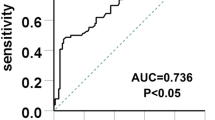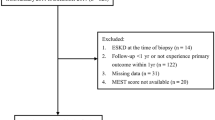Abstract
Objective
To construct a novel nomogram model that predicts the risk of hyperuricemia incidence in IgA nephropathy (IgAN).
Methods
Demographic and clinicopathological characteristics of 1184 IgAN patients in the First Affiliated Hospital of Zhengzhou University Hospital were collected. Univariate analysis and multivariate logistic regression were used to screen out hyperuricemia risk factors. The risk factors were used to establish a predictive nomogram model. The performance of the nomogram model was evaluated using an area under the receiver-operating characteristic curve (AUC), calibration plots, and a decision curve analysis.
Results
Independent predictors for hyperuricemia incidence risk included sex, hypoalbuminemia, hypertriglyceridemia, blood urea nitrogen (BUN), estimated glomerular filtration rate (eGFR), 24 h urinary protein (24 h TP), gross hematuria and tubular atrophy/interstitial fibrosis (T). The nomogram model exhibited moderate prediction ability with an AUC of 0.834 (95% CI 0.804–0.864). The AUC from validation reached 0.787 (95% CI 0.736–0.839). The decision curve analysis displayed that the hyperuricemia risk nomogram was clinically applicable.
Conclusion
Our novel and simple nomogram containing 8 factors may be useful in predicting hyperuricemia incidence risk in IgAN.



Similar content being viewed by others
Data availability
All relevant data during this study are included in this article. Further enquiries can be directed to the corresponding author.
References
Rekola S, Bergstrand A, Bucht H (1991) Deterioration of GFR in IgA nephropathy as measured by 51Cr-EDTA clearance. Kidney Int 40(6):1050–1054. https://doi.org/10.1038/ki.1991.313
Liu R, Han C, Wu D et al (2015) Prevalence of Hyperuricemia and Gout in Mainland China from 2000 to 2014: a systematic review and meta-analysis. Biomed Res Int 2015:762–820. https://doi.org/10.1155/2015/762820
Qiu Q, Chen XM, Xie YS (2005) Factors affecting hyperuricemia in IgA nephropathy. Chin J Nephrol Integr Tradit Chin West Med 6:329–331
Bakan A, Oral A, Elcioglu OC et al (2015) Hyperuricemia is associated with progression of IgA nephropathy. Int Urol Nephrol 47(4):673–678. https://doi.org/10.1007/s11255-015-0939-7
Moriyama T, Itabashi M, Takei T et al (2015) High uric acid level is a risk factor for progression of IgA nephropathy with chronic kidney disease stage G3a. J Nephrol 28(4):451–456. https://doi.org/10.1007/s40620-014-0154-0
Zhu B, Yu DR, Lv JC et al (2018) Uric Acid as a predictor of immunoglobulin a nephropathy progression: a cohort study of 1965 cases. Am J Nephrol 48(2):127–136. https://doi.org/10.1159/000489962
Cheng GY, Liu DW, Zhang N et al (2013) Clinical and prognostic implications of serum uric acid levels on IgA nephropathy: a cohort study of 348 cases with a mean 5-year follow-up. Clin Nephrol 80(1):40–46. https://doi.org/10.5414/CN107813
Le W, Liang S, Hu Y, Deng K, Bao H, Zeng C, Liu Z (2012) Long-term renal survival and related risk factors in patients with IgA nephropathy: results from a cohort of 1155 cases in a Chinese adult population. Nephrol Dial Transplant Off Publ Eur Dial Transplant Assoc Eur Ren Assoc 27(4):1479–1485. https://doi.org/10.1093/ndt/gfr527
Shi Y, Chen W, Jalal D, Li Z, Chen W, Mao H, Yang Q, Johnson RJ, Yu X (2012) Clinical outcome of hyperuricemia in IgA nephropathy: a retrospective cohort study and randomized controlled trial. Kidney Blood Press Res 35(3):153–160. https://doi.org/10.1159/000331453
Kramer H (2019) Diet and chronic kidney disease. Adv Nutr (Bethesda, Md.) 10:S367–S379. https://doi.org/10.1093/advances/nmz011
Johnson RJ, Kang DH, Feig D, Kivlighn S, Kanellis J, Watanabe S, Tuttle KR, Rodriguez-Iturbe B, Herrera-Acosta J, Mazzali M (2003) Is there a pathogenetic role for uric acid in hypertension and cardiovascular and renal disease? Hypertension (Dallas, Tex.: 1979) 41(6):1183–1190. https://doi.org/10.1161/01.HYP.0000069700.62727.C5
Le WB, Liang SS, Deng KP et al (2011) 1126 cases of IgA nephropathy in Chinese Han adults long term prognosis and risk factors of renal disease. J Ren Dial Ren Transplant 20:101–108
Syrjänen J, Mustonen J, Pasternack A (2000) Hypertriglyceridaemia and hyperuricaemia are risk factors for progression of IgA nephropathy. Nephrol Dial Transplant Off Publ Eur Dial Transplant Assoc Eur Ren Assoc 15(1):34–42. https://doi.org/10.1093/ndt/15.1.34
Roberts IS (2014) Pathology of Ig A nephropathy. Nat Rev Nephrol 10(8):445–454
Levey AS, Stevens LA, Schmid CH et al (2009) A new equation to estimate glomerular filtration rate. Ann Intern Med 150(9):604–612. https://doi.org/10.7326/0003-4819-150-9-200905050-00006
Mei CL, Zhang T (2016) Kidney disease [M]. Second Military Medical University Press, Shanghai
Trimarchi H, Barratt J, Cattran DC, IgAN Classification Working Group of the International IgA Nephropathy Network and the Renal Pathology Society, & Conference Participants et al (2017) Oxford classification of IgA nephropathy 2016: an update from the IgA nephropathy classification working group. Kidney Int 91(5):1014–1021. https://doi.org/10.1016/j.kint.2017.02.003
Liu ZW (1980) Akachi information criterion AIC and its significance. Pract Underst Math 03:64–72
Lu P, Li X, Zhu N, Deng Y et al (2020) Serum uric acid level is correlated with the clinical, pathological progression and prognosis of IgA nephropathy: an observational retrospective pilot-study. PeerJ 8:e10130. https://doi.org/10.7717/peerj.10130
Cai Lu, Bai YW (2014) Hyperuricemia and its risk factors in patients with IgA nephropathy. Chin Community Phys 30(06):118–119
Yi F, Lan L, Jiang J, Peng L, Jin Y, Zhou X (2021) The Related Factors of Hyperuricemia in IgA Nephropathy. Iran J Kidney Dis 15(4):256–262
Funding
YFL received a National Natural Science Foundation of China (81701601). The funders had no role in study design, data collection and analysis, decision to publish, or preparation of the manuscript.
Author information
Authors and Affiliations
Contributions
Data curation: ZZ, BH, and Z-SG. Formal analysis: Y-HG. Investigation: ZZ, S-XQ, and C-DS. Supervision: Y-FL, X-TW, R-MH, and F-YD. Writing—original draft: Y-HG. Writing—review and editing: J-JZ, L-QZ, and Y-FL.
Corresponding author
Ethics declarations
Conflict of interest
The authors have no conflicts of interest to declare availability of data and material.
Ethical approval
It was approved by the First Affiliated Hospital of Zhengzhou University Hospital Ethics Committee (Ethical review number: 2022-KY-0048-002).
Additional information
Publisher's Note
Springer Nature remains neutral with regard to jurisdictional claims in published maps and institutional affiliations.
Rights and permissions
Springer Nature or its licensor (e.g. a society or other partner) holds exclusive rights to this article under a publishing agreement with the author(s) or other rightsholder(s); author self-archiving of the accepted manuscript version of this article is solely governed by the terms of such publishing agreement and applicable law.
About this article
Cite this article
Geng, YH., Zhang, Z., Zhang, JJ. et al. Established the first clinical prediction model regarding the risk of hyperuricemia in adult IgA nephropathy. Int Urol Nephrol 55, 1787–1797 (2023). https://doi.org/10.1007/s11255-023-03498-0
Received:
Accepted:
Published:
Issue Date:
DOI: https://doi.org/10.1007/s11255-023-03498-0




